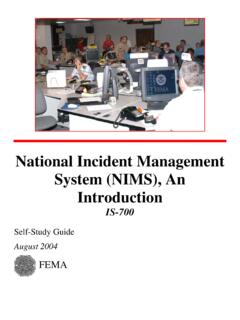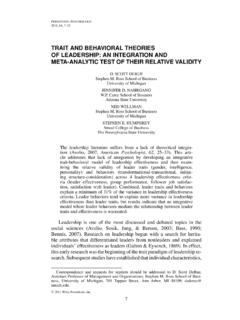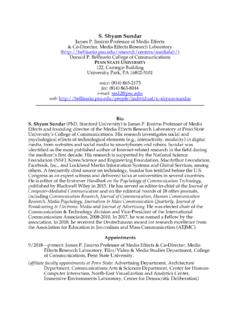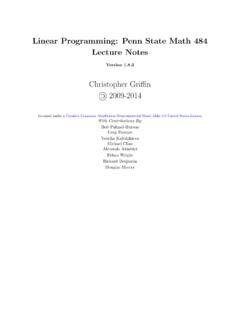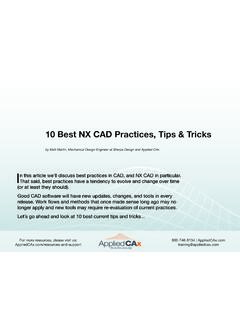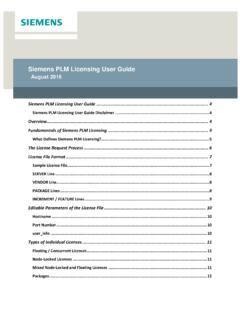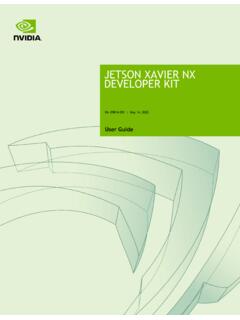Transcription of Sequences of functions Pointwise and Uniform Convergence
1 MATH 401 - NOTESS equences of functionsPointwise and Uniform ConvergenceFall 2005 Previously, we have studied Sequences ofreal numbers. Now we discussthe topic ofsequences of real valued functions . A sequence of functions {fn}is a list of functions (f1,f2,..) such that eachfnmaps a given Pointwise a subset ofRand let{fn}be a sequence of functionsdefined onD. We say that{fn}converges Pointwise onDiflimn fn(x)exists for each means that limn fn(x) is a real number that depends only {fn}is Pointwise convergent then the function defined byf(x) = limn fn(x),for everyxinD, is called thepointwise limit of the sequence{fn}.Example {fn}be the sequence of functions onRdefined byfn(x) =nx. This sequence does not converge Pointwise onRbecause limn fn(x) = for anyx> {fn}be the sequence of functions onRdefined byfn(x) =x/n.
2 Thissequence converges Pointwise to the zero function the sequence{fn}of functions defined byfn(x) =nx+x2n2for that{fn}converges :For every real numberx, we have:limn fn(x) = limn xn+x2n2=x(limn 1n)+x2(limn 1n2)= 0 + 0 = 01 Thus,{fn}converges Pointwise to the zero function the sequence{fn}of functions defined byfn(x) =sin(nx+ 3) n+ 1for that{fn}converges :For everyxinR, we have 1 n+ 1 sin(nx+ 3) n+ 1 1 n+ 1 Moreover,limn 1 n+ 1= the squeeze theorem for Sequences , we obtain thatlimn fn(x) = 0 for ,{fn}converges Pointwise to the functionf 0 the sequence{fn}of functions defined byfn(x) =n2xnfor0 x 1. Determine whether{fn}is Pointwise :First of all, observe thatfn(0) = 0 for everyninN. So thesequence{fn(0)}is constant and converges to zero. Now suppose 0<x<1thenn2xn=n2enln(x).
3 But ln(x)<0 when 0<x<1, it follows thatlimn fn(x) = 0 for 0<x<1 Finally,fn(1) =n2for alln. So, limn fn(1) = . Therefore,{fn}is notpointwise convergent on [0,1].Example {fn}be the sequence of functions defined byfn(x) = cosn(x)for /2 x /2. Discuss the Pointwise Convergence of the :For /2 x<0 and for 0<x /2, we have0 cos(x)< follows thatlimn (cos(x))n= 0 forx6= , sincefn(0) = 1 for allninN, one gets limn fn(0) = 1. Therefore,{fn}converges Pointwise to the functionfdefined byf(x) ={0 if 2 x<0 or 0<x 21 ifx= 0 Example the sequence of functions defined byfn(x) =nx(1 x)non [0,1].Show that{fn}converges Pointwise to the zero :Note thatfn(0) =fn(1) = 0, for alln N. Now suppose0<x<1, thenlimn fn(x) = limn nxenln(1 x)=xlimn nenln(1 x)= 0because ln(1 x)<0 when 0<x<1.}
4 Therefore, the given sequence con-verges Pointwise to {fn}be the sequence of functions onRdefined byfn(x) ={n3if0<x 1n1 otherwiseShow that{fn}converges Pointwise to the constant functionf= :For anyxinRthere is a natural numberNsuch thatxdoesnot belong to the interval (0,1/N). The intervals (0,1/n) get smaller asn . Therefore,fn(x) = 1 for alln>N. Hence,limn fn(x) = 1 for formal definition of Pointwise convergenceLetDbe a subset ofRand let{fn}be a sequence of real valued functionsdefined onD. Then{fn}converges Pointwise tofif given anyxinDandgiven any >0, there exists a natural numberN=N(x, ) such that|fn(x) f(x)|< for everyn> :The notationN=N(x, ) means that the natural numberNdependson the choice ofxand .3I. Uniform a subset ofRand let{fn}be a sequence of realvalued functions defined onD.}
5 Then{fn}converges uniformly tofif givenany >0, there exists a natural numberN=N( ) such that|fn(x) f(x)|< for everyn>Nand for :In the above definition the natural numberNdepends only on .Therefore, Uniform Convergence implies Pointwise Convergence . But the con-verse is false as we can see from the following {fn}be the sequence of functions on(0, )defined byfn(x) =nx1 + function converges Pointwise to zero. Indeed, (1 +n2x2) n2x2asngets larger and larger. So,limn fn(x) = limn nxn2x2=1xlimn 1n= for any <1/2, we have fn(1n) f(1n) =12 0> .Hence{fn}is not uniformly a subset ofRand let{fn}be a sequence ofcontinuousfunctions onDwhich converges uniformly tofonD. Thenfis continuousonD4 HomeworkProblem {fn}be the sequence of functions on [0,1] defined byfn(x) =nx(1 x4) that{fn}converges Pointwise .
6 Find its Pointwise the sequence of functions on [0,1) defined byfn(x) = (1 x)1npointwiseconvergent? Justify your the sequence{fn}of functions defined byfn(x) =n+ cos(nx)2n+ 1for that{fn}is Pointwise convergent. Find its Pointwise the sequence{fn}of functions defined on [0, ] byfn(x) = sinn(x).Show that{fn}converges Pointwise . Find its Pointwise limit. Using theabove theorem, show that{fn}is not uniformly]
